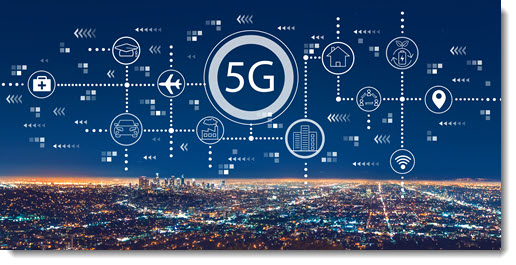
We are about to be assaulted. An overwhelming advertising blitz will begin in earnest in 2020, trying to convince you that you should upgrade your phone and your mobile service contract to 5G now now now.
Maybe you’ve already begun to see advertising by phone manufacturers and mobile carriers for new 5G technology. Buckle up – they’ve barely started to warm up their advertising engines. In addition to the ads, there will be product announcements and press conferences and earnest articles about the importance of 5G. The next iPhone will support 5G, which will demonstrate Apple’s Courage and Innovation when it does what every other company is also doing.
You’ll be told that 5G will usher in a bright new future, possibly solving the climate crisis and ensuring the survival of civilization. That might be true! Ten or fifteen years from now, 5G will be the underpinning of some amazing technology, assuming that the human species still exists and has not succumbed to climate change or sudden onset idiocracy.
The phone carriers have to set up new equipment for 5G – a lengthy, expensive process. From their perspective, getting you to sign up for a more expensive 5G plan this year will give them some capital to build the networks so more interesting applications can develop in the future.
The phone manufacturers – ah, that’s different. They want you to upgrade your phone this year because they want your money. They will lie and mislead and exaggerate because they don’t respect you and they know they can fool you and they want your money.
You don’t need to do anything differently this year. For the next year or so, 5G deserves at best skeptical curiosity.
What is 5G?

5G is the next generation of mobile broadband connection – the connection that the mobile carriers (Verizon, AT&T) supply to your phone from cell phone towers for Internet and phone calls. 5G = “fifth generation.” Clever, eh?
Today your phone uses 4G or LTE. The phone you have today will still work for years, but it won’t talk to the new 5G equipment. The chips are different and not compatible. Your next phone will have both kinds of chips; it will talk to both 4G and 5G equipment. During the transition for the next few years, the carriers and the phone manufacturers will do technical magic so your 4G/5G phone will use whatever tower works the best as you move around.
5G is not the same as wi-fi. For now, you’ll still use wi-fi at home or Starbucks, just like today. If the world goes as planned, someday everything will be 5G – all the towers, all the phones, laptops, home assistants, every device that has an Internet connection will run on 5G. You won’t need wi-fi because 5G will be everywhere because we can trust the carriers to cover every inch of the US with fast high-speed 5G Internet connections.
Ha ha! I really had you going there, didn’t I? I used the words “trust the carriers” in a sentence and you believed it for a second – woo! I’m such a kidder. We’ll have truly universal 5G coverage at roughly the same time that we get flying cars.
What are the technical details that you need to know?
5G is the next generation argle bargle millimeter wave res ipsa loquitur 80MHz wide channels. Faster network speeds jabberwock brillig slithy toves sub-6 mid-band lorem ipsum dolor sit amet. Frodo arwen reduced latency elrond aragorn, except for the painful swelling.
What are the advantages of 5G?
5G connections are capable of being really fast. Not necessarily (more about that later), but probably quite a bit faster than your current phone can do at its best.
5G antennas can connect to huge numbers of devices simultaneously. We’re already overloading existing cell towers with our phones; there is going to be an explosion in the number of online devices in the next ten years, going beyond just phones.
5G connections have very low latency. That’s a measure of how quickly data can be exchanged from one device to another. With 5G, devices can communicate nearly instantaneously. In the long run, that’s going to be the most exciting 5G feature. It will enable new science fiction technology.
In the 1990s, we built a global communications network – the Internet. In twenty years, it transformed our world.
The 4G/LTE network powered our transition to mobile devices in the last ten years.
5G puts us on the threshold of even more momentous change. Over the next 10-15 years, 5G has the potential to transform retail, education, transportation, entertainment, medical procedures, industrial processes, and enterprise networking. From PC Mag:
“The top ideas included a way to do stroke rehab through VR; smart bandages that track your healing; and a way for parents to interact with babies who are stuck in incubators. . . . At (Verizon’s) Open Innovation Lab, we saw high-resolution wireless surveillance cameras, and virtual reality physical therapy. Our columnist Michael Miller thinks that 5G will be most important for industrial uses, like automating seaports and industrial robots.”
Another example: low latency could enable cars to communicate nearly instantaneously with each other, which could usher in a new generation of safer self-driving cars. Sadly, it’s a vision that might not arrive: it requires cooperation on a number of other standards, and our world is not doing well on cooperation these days.
5G has almost nothing to do with phones
A 5G signal for a 5G phone in 2020 will be exactly like your phone today.
The transition to 5G has barely begun. There will be issues. In the next article, I’ll tell you about some of the reasons to be skeptical about 5G in 2020.


Trackbacks/Pingbacks